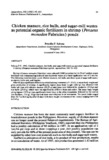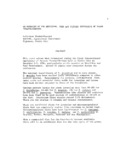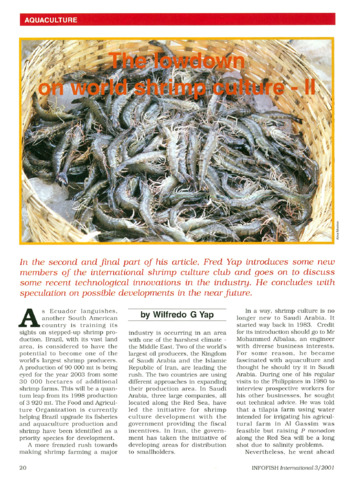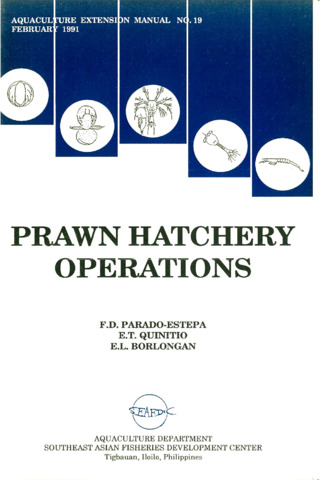Chicken manure, rice hulls, and sugar-mill wastes as potential organic fertilizers in shrimp (Penaeus monodon Fabricius) ponds

View/
Request this document
Date
1992Author
Page views
130Metadata
Show full item recordCited times in Scopus
Share
Abstract
Shrimp (Penaeus monodon Fabricius) were cultured (3000 juveniles/ha) in 50-m2 earthen ponds fertilized with composted agricultural and industrial wastes at a basal application rate of 2 ton/ha. The following materials were tested: chicken manure, rice hulls, and three types of sugar-mill wastes: mudpress, boiler ash, and bagasse.
After 66 days significant differences existed among treatments (P < 0.05) in mean body weight and gross production of shrimp. A significantly higher mean body weight (28.8 g) was obtained with boiler ash than with chicken manure (26.05 g) and these were followed by mudpress (25.8 g) and rice hulls (25.05 g) which were not significantly different from each other. The mean body weight using bagasse (22.0 g) was significantly lower than in the other treatments followed by the control (no fertilizer, 19.6 g). High survival rates were obtained in all treatments. The pond yields ranged from 53.7 to 86.4 kg/ha after 66 days with daily weight increments of the shrimp ranging from 0.18 to 0.41 g.
Suggested Citation
Subosa, P. F. (1992). Chicken manure, rice hulls, and sugar-mill wastes as potential organic fertilizers in shrimp (Penaeus monodon Fabricius) ponds. Aquaculture , 102(1-2), 95-103. https://doi.org/10.1016/0044-8486(92)90292-S
Subject
Taxonomic term
Collections
- AQD Journal Articles [1215]
Related items
Showing items related by title, author, creator and subject.
-
An overview of the nutrition, feed and feeding techniques of prawn penaeid/shrimps
Piedad-Pascual, Felicitas (Philippine Council for Aquatic and Marine Research and Development, 1989)This paper echoes what transpired during the first International Conference of Penaeid Prawns/Shrimps held in Iloilo City in December 4-7, 1984, particularly on the Nutrition nd Feed Development. Around 25 papers were ... -
The lowdown on world shrimp culture - II
Yap, Wilfredo G. (INFOFISH, 2001)This paper introduces some new members of the international shrimp culture club and goes on to discuss some recent technological innovations in the industry, particularly the polyculture of tilapia (mainly Oreochromis ... -
Prawn hatchery operations
Parado-Estepa, Fe D.; Quinitio, Emilia T.; Borlongan, Emeterio L. (Aquaculture Department, Southeast Asian Fisheries Development Center, 1991-02)The manual, an updated version of the 1984 SEAFDEC/AQD manual, presents the underlying principles and step-by-step instructions of prawn larval and post-larval rearing. The techniques described are not only applicable to ...





